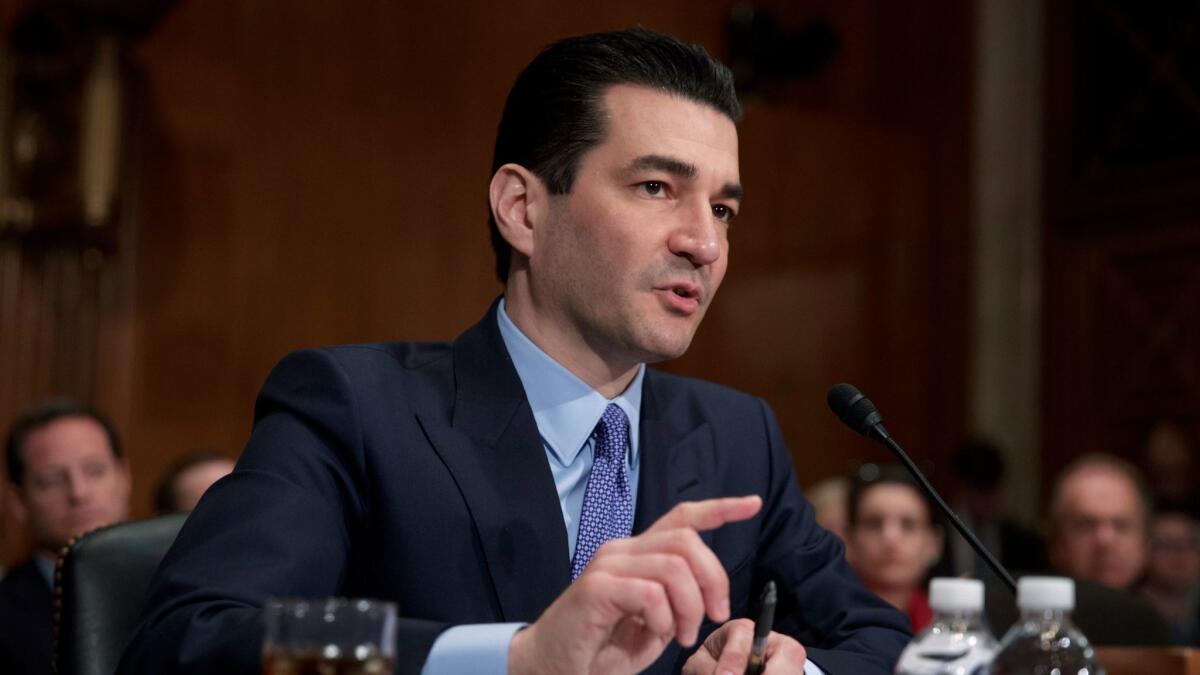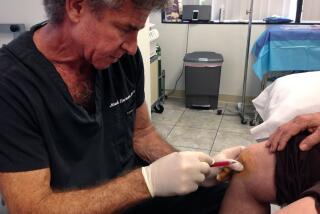Column: The FDA closes a huge loophole used by bogus stem-cell clinics, but delays serious enforcement for 3 years

There was good news and bad news in the regulatory initiative the Food and Drug Administration rolled out on Thursday, aimed partially at clinics marketing unproven stem-cell therapies directly to consumers.
The good news is that the FDA firmly closed a loophole exploited by many of these proliferating clinics. Those that say they’re using liposuctioned fat to produce stem cells that they reinject in a patient to treat a host of medical conditions, the FDA says, are selling a drug. That means they need to be specially licensed and subjected to inspection.
Here’s the bad news: The agency is giving the clinics up to 36 months to comply with the regulations. That’s far too indulgent.
This is nowhere close to a red line; at best, it’s amber.
— Bioethicist Leigh Turner
“Three years is a long time for potentially non-compliant clinics to still be raking in the dough from patients,” observes Paul Knoepfler, a UC Davis stem-cell biologist who has spent more than a year documenting the spread of clinics hawking unproven stem-cell nostrums. The agency said it would prioritize enforcement during that period, focusing on “products that pose a potential significant safety concern.”
Indeed, the FDA’s hands-off approach to enforcing its own rules could encourage the further spread of such clinics, rather than clamping down on the proliferation. That’s the view of Leigh Turner, a University of Minnesota bioethicist who co-wrote a survey of proliferating clinics with Knoepfler.
“This is nowhere close to a red line; at best, it’s amber,” Turner said of the FDA’s enforcement plans. “A lot of people running these businesses are going to see this as an opportunity to carry on as before, or if they’re not in the business, to dive into the marketplace.” Over the next 36 months, he says, the direct-to-consumer stem-cell business is going to get larger, richer and more politically influential — and therefore more of a threat to public health.
The FDA on Thursday released four policy papers on stem-cell treatments. Two, aimed at regulating what we might think of as legitimate stem cell-based treatments, are draft guidelines open to public comment. The other two are final regulations aimed at the proliferating direct-to-consumer clinics. We’ve been reporting on this shadowy corner of the medical marketplace, in which clinics charge consumers thousands of dollars for untested, unscientific and unproven treatments.
FDA Commissioner Scott Gottlieb turned his gun sights squarely on the “bad actors” in this field when he announced his agency’s regulatory initiative. Among them are clinics that charge desperate patients as much as $15,000, not including travel expenses, for treatments that are seldom covered by insurance. The treatments are not approved by the FDA and are backed by virtually no scientific evidence to prove their efficacy.
“The rapid growth and promise of this field has increasingly sowed the ground for the entry of some unscrupulous actors, who have opportunistically seized on the clinical potential of regenerative medicine to make deceptive claims to patients about unproven and, in some cases, dangerous products,” Gottlieb said. “By exploiting the lack of consumer understanding of this area, as well as the fear and uncertainties posed by the diseases these bad actors claim to treat, they’re jeopardizing the legitimacy and advancement of the entire field.”
Some clinics have tried to skirt FDA regulations by claiming that by treating liposuctioned fat to extract stem cells, they’re engaging in “minimal manipulation” of patients’ own tissues, a well-known exemption to the agency’s definition of a regulated drug.
The FDA final guidelines say “no dice” to that. Minimal manipulation, they state, means minor handling such as rinsing or filtration to remove debris and other impurities. Taking steps to “isolate stem cells,” as many clinics claim they’re doing, is out of bounds and requires special licensing and possible inspections.
Using tissue-derived stem cells to treat conditions unrelated to the original tissue is also nonexempt, the FDA says. That’s a shot at the claims of stem-cell clinics that they can use fat-derived stem cells to treat disorders that have nothing to do with fat, such as multiple sclerosis, Parkinson’s, pulmonary conditions or rheumatoid arthritis — conditions that stem-cell clinics around the country imply they can treat.
The FDA’s initiative this week adds specifics to a theme Gottlieb has been articulating since he took over the agency on May 11. In August, the FDA seized nearly 500 doses of a smallpox vaccine that was to be combined with stem cells derived from body fat and administered to patients in clinics in Beverly Hills and Rancho Mirage, Calif. The agency also published a blistering warning letter delivered to U.S. Stem Cell Clinic of Sunrise, Fla., for “marketing stem cell products without FDA approval.”
U.S. Stem Cell ran a Florida clinic that reportedly injected a stem-cell solution into the eyeballs of three elderly women suffering macular degeneration. According to the New England Journal of Medicine, the patients suffered permanent partial or complete blindness because of the treatment. The firm’s chief scientific officer, Kristin Comella, testified at an FDA hearing in 2016 that its stem-cell treatments should be exempted under the “minimally manipulated” standard. She said the number of “adverse events” that had been reported among thousands of patients was “just a handful.” She gave her testimony before the vision cases were reported by the New England Journal.
U.S. Stem Cell has acknowledged performing the eye procedures, but says that it has ceased doing them and that it settled with the patients under conditions of confidentiality.
The FDA, for its part, has issued just a handful of warning letters to stem-cell clinics, including the notice to U.S. Stem Cell. It should be taking firmer action, Turner says. “If Thursday the FDA had put out a press release and said, ‘We’ve issued warning letters to 20 businesses’ and picked 20 of the more visible businesses in this marketplace, that would have had a meaningful effect.”
Instead, he argues, the FDA is just deepening a hole that it created itself. “If the FDA had done something meaningful around 2009 and these businesses hadn’t proliferated,” he says, “there wouldn’t be this huge regulatory challenge facing the FDA, where there are hundreds of these businesses and they say they can’t possibly regulate them all, so they have to prioritize their resources and just pick the most outrageous ones.
“The FDA is part of the very problem they’re now responsible for addressing. They did very little for years, and if they had done a better job of it over the last seven or eight years, we’d be in a very different place.”
Keep up to date with Michael Hiltzik. Follow @hiltzikm on Twitter, see his Facebook page, or email [email protected].
Return to Michael Hiltzik’s blog.







